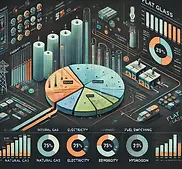
Energy Consumption Breakdown
Energy breakdown of different configurations for quicklime decarbonisation
Energy Demand and Emissions in Lime Kilns
Quicklime production necessitates high-temperature kilns to perform the calcination reaction, converting limestone into quicklime and CO₂. This analysis compares eight kiln configurations based on energy demand and CO₂ emissions:
-
NG – Conventional natural gas air-fired kiln
-
NGOxy – Natural gas oxy-fired kiln for concentrated flue gases
-
Plasma – Plasma-based electrified kiln
-
BioCH4 – Uses biomethane as a clean fuel
-
BioCH4Oxy – Biomethane oxy-fired kiln for concentrated flue gases
-
H2Oxy – Hydrogen oxy-fired kiln for concentrated flue gases
-
Biomass – Uses solid biomass (wood) as a clean fuel
-
BiomassOxy – Biomass oxy-fired kiln for concentrated flue gases
Energy Demand Components (GJ/t)
-
Q-Process – Thermal energy for limestone calcination
-
EL-Process – Electrical demand for kiln operation
-
EL-ASU – Electricity for oxygen production in oxy-fuel systems
-
Q-CCS – Heat required by chemical absorption-based CO₂ capture
-
EL-CCS – Power required by absorption-based CO₂ capture (Ch.Abs.) or cryogenic CO₂ capture (CO2CPU)
-
EL-Electrolyzer – Electricity for green hydrogen production
Carbon Capture (CCUS) Impact
Switch the toggle on to observe the impact of CC implementation.
CCS increases energy demand due to CO₂ separation and compression but reduces overall total emissions (emitted during calcination reaction, fossil fuel combustion, and upstream energy carriers production) per ton of lime.